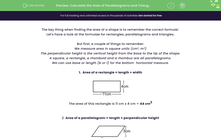The key thing when finding the area of a shape is to remember the correct formula!
Let's have a look at the formulae for rectangles, parallelograms and triangles.
But first, a couple of things to remember:
We measure area in square units (cm², m²)
The perpendicular height is the vertical height from the base to the tip of the shape.
A square, a rectangle, a rhomboid and a rhombus are all parallelograms.
We can use base or length (b or l) for the bottom horizontal measure.
1. Area of a rectangle = length × width
The area of this rectangle is 11 cm x 4 cm = 44 cm2
2. Area of a parallelogram = length × perpendicular height
The area of this parallelogram is 8 cm x 3 cm = 24 cm2
3. Area of a triangle = base × perpendicular height ÷ 2
This is because you can fit two triangles inside a rectangle.
The area of this triangle is (12 cm x 8 cm) ÷ 2 = 48 cm2
That wasn't too painful, was it? If you need to check back to these formulae, just click on the red help button on the screen so that you can read the introduction again.

Let's get started - good luck!








